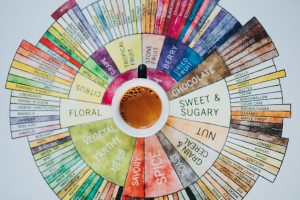Lessons From Coffee Cupping
From green coffee buyers, coffee roasters, baristas, roaster machine specialists, cafe owners, and many more professions along the supply chain of the industry, coffee is evaluated and scored by a universal standardized method known as coffee cupping. In our previous blog post, we have talked about how to rate your roast by cupping. We defined what is coffee cupping, what flavors to look for during a cupping session and how to avoid the pitfalls. In this blog, we will talk in more detail on how to conduct a cupping session and what lesson we can learn from coffee cupping.
Preparing And Conducting a Cupping Session
By definition, coffee cupping is a way to test, evaluate and score the flavor of a certain coffee. For coffee roasters, it is an important activity for sourcing coffee, rating the roast profiles, maintaining quality and consistency, and also passing on the knowledge to other roasters in the coffee industry. During a typical cupping session, two or more coffees are prepared in the exact same way and then each of them is evaluated using the exact same method.
What you need to prepare:
- Freshly roasted coffee beans
- Clean, filtered water heated up to 200°F (93°C)
- A grinder
- Cups of the same size and weight
- Spoons
- A scale and a timer
- SCA flavor wheel, if available
- Pen and paper for taking notes
What you need to do:
- Weigh each coffee bean and grind coarsely. Put into the cupping bowls, using two bowls for each sample to avoid the risk of defects.
- Evaluate the dry aroma and take notes.
- Pour the hot water as you start the timer, ensure that each cup has the exact amount of hot water.
- Assess the wet aroma and take notes.
- After 4 minutes, start to break the crust by pushing the coffee grounds to the back of the bowl using a spoon. Remember to rinse the spoon after breaking the crust in each bowl. Do another wet aroma assessment at this stage.
- Using two spoons, skim off the grounds, foams, and oils.
- Allow the coffee to cool, and after 7-10 minutes you can start tasting the coffee. Slurp the coffee to spread it along your tongue to get the full range of flavors. Take notes.
To conduct an efficient cupping session, you should prepare a clean, neutral, well-lit space that is free from odor and noise. Coffee cuppers should cleanse their palate between each tasting, and avoid cupping right after eating, drinking, brushing teeth or chewing gum. Ideally, cupping should happen when the senses are most alert, around 2-3 hours after waking up.

Lessons from Coffee Cupping
Below are our takeaways from the cupping session:
- Know your goal
Either you are a green coffee buyer, a coffee roaster, a barista, a cafe owner, set the intention on what you want to achieve with the cupping session.
- Consistency is key
Make an effort to prepare each sample set that is as identical as possible to one another. Each type of coffee bean should be ground the same way, brewed the same way, and tasted the same way.
- Cupping is a comparable evaluation
Cupping may look like a series of steps that you have to follow through, but the results may vary from one person to another depending on each person’s palate. During the cupping, there is usually very little conversation to avoid influencing other cuppers, but it doesn’t mean you cannot compare notes afterward to gain insight and knowledge.
- You may or may not use cupping forms and scoresheets
There are a number of official cupping forms and scoresheets that you can use to help you score coffee properly. You can use them all, use some of them, or none at all. Some experts even design their own scoring systems.
- Trust your senses
Let your nose be the guide for the aroma, as a large part of what we perceive as flavor is actually derived from our sense of smell. Rely on your sense of taste as well, lean into the slurp, distribute the coffee evenly around your mouth and allow the coffee to sit for a while before swallowing or spitting it out.
- Practice makes perfect
There is no other way to increase your skill and improve your palate aside from doing more and more cupping sessions.
Cupping is a great method to expand your palate. Taking notes of aromatics, flavor, and other components of the coffee also helps you to understand the different senses you taste in each coffee. Because everyone has a distinctive palate, you may pick up different characteristics of a coffee than the person next to you. Have fun cupping and comparing notes!


